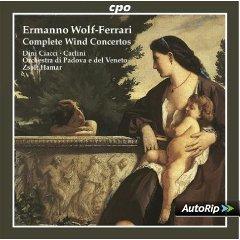Ermanno Wolf-Ferrari - Complete Wind Concertos (2007)
Ermanno Wolf-Ferrari - Complete Wind Concertos (2007)

1. Idillio-concertino in A Major, Op. 15: I. Preambola 3:06 2. Idillio-concertino in A Major, Op. 15: II. Scherzo 3:17 3. Idillio-concertino in A Major, Op. 15: III. Adagio 7:30 4. Idillio-concertino in A Major, Op. 15: IV. Rondo 6:21 5. Suite-concertino in F Major, Op. 16: I. Notturno: Andante un poco mosso 9:42 6. Suite-concertino in F Major, Op. 16: II. Strimpellata: Presto 2:13 7. Suite-concertino in F Major, Op. 16: III. Canzone: Andante cantabile 5:23 8. Suite-concertino in F Major, Op. 16: IV. Andante con moto 5:59 9. Concertino in A-Flat Major, Op. 34: I. Preludio 5:16 10. Concertino in A-Flat Major, Op. 34: II. Capriccio 6:44 11. Concertino in A-Flat Major, Op. 34: III. Adagio 8:15 12. Concertino in A-Flat Major, Op. 34: IV. Finale 5:54 Diego Dini-Ciacci (Oboe, English Horn) Paolo Carlini (Bassoon) Padua and Veneto Orchestra Zsolt Hamar (Conductor)
Lovely, melodic, and ephemeral, these three concertos by German-Italian composer Ermanno Wolf-Ferrari will charm listeners looking for twentieth century music that recalls with warm nostalgia the final years of the nineteenth century. Each concerto is in four movements and scored for different woodwind soloists plus a small orchestra. Both the delightful Idillio-Concertino for oboe and the sonorous Suite-Concertino for bassoon were premiered in 1933 while the wistfully tuneful Concertino for English Horn was posthumously premiered in 1955, seven years after the composer's death. All three are thoroughly Romantic in their arching melodies, chromatic harmonies, and freewheeling approach to form, and faintly neo-classical in their ebullient tone, buoyant rhythms, and ever-so-slightly ironic wit. Superbly played by Diego Dini-Ciacci on oboe and english horn and by Paolo Carlini on bassoon, and enthusiastically accompanied by the Orchestra di Padova e del Veneto led by Zsolt Hamar, Wolf-Ferrrari's concertos are as appealing as cheese, apples, and wine in autumn. Recorded in Padua's Pollini Auditorium, the soloists here sound much too close while the orchestra sounds too far away. The result is an unrealistic and sometimes unpleasant sound. ---James Leonard, Rovi
Wolf-Ferrari (1876–1948) was born in Venice, Italy, the son of a German father and an Italian mother. He enjoyed early success with his operas and he also distinguished himself in the genres of chamber music and concertante wind music. The three works on this album, all cast in four short movements, are scored for small orchestras. All are comparatively late works. In each, soloists and orchestra are equal partners. The “Idillio” Concertino, premiered in 1933, is written in a light late-Romantic vein with string orchestra augmented by two horns imparting something of a bucolic character. It is reminiscent of the neo-Classical style of Respighi, especially in the Scherzo, where staccato chords from the oboe and answering strings are reminiscent of Respighi’s hen from The Birds . Both Dini Ciacci and Van Bockstal please with the latter just that bit snappier and more extroverted in the jolly outer movements. The hauntingly beautiful Adagio, taken at a much slower pace by Dini Ciacci and Hamar, is distinguished by some delectable string phrasing. The cpo players also make magic of the atmospheric Notturno opening movement of the Suite-Concertino for bassoon and small orchestra (1933), Hamar drawing lovely limpid music from his strings; and if you thought a bassoon could never be romantic, then you should listen to Carlini’s tender love song that is the Canzone (Andante cantabile). Loubry, on Talent, is more bubbly in the presto Strimpellata movement.
Wolf-Ferrari’s Concertino for English horn, strings, and two horns was premiered posthumously in Salzburg in 1955. Listening to the Capriccio second movement, and the Finale, one might imagine commedia dell’arte characters, the English horn’s buffoonery, sometimes encouraged by prankish horns, contrasts with the strings’ frequent censorious tones; Stravinsky’s Pulcinella comes to mind. Once again, the affecting melancholy of Carlini’s English horn solo, combined with misty, atmospheric strings, lifts another exquisite Wolf-Ferrari Adagio, the horns adding perspective and heightening the elegiac mood. ---Ian Lace, arkivmusic.com
download (mp3 @320 kbs):
uploaded yandex 4shared mega mediafire solidfiles zalivalka cloudmailru oboom








